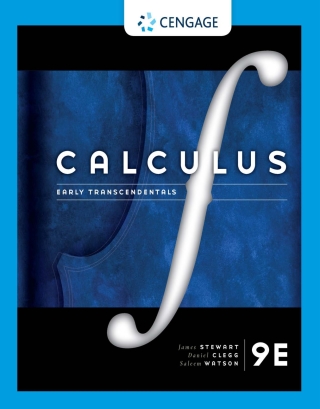Buy Calculus: Early Transcendentals, 9th Edition PDF ebook by author James Stewart; Daniel K. Clegg; Saleem Watson – published by Cengage Learning in 2021 and save up to 80% compared to the print version of this textbook. With PDF version of this textbook, not only save you money, you can also highlight, add text, underline add post-it notes, bookmarks to pages, instantly search for the major terms or chapter titles, etc.
You can search our site for other versions of the Calculus: Early Transcendentals, 9th Edition PDF ebook. You can also search for others PDF ebooks from publisher Cengage Learning, as well as from your favorite authors. We have thousands of online textbooks and course materials (mostly in PDF) that you can download immediately after purchase.
Note: e-textBooks do not come with access codes, CDs/DVDs, workbooks, and other supplemental items.
eBook Details:
Full title: Calculus: Early Transcendentals, 9th Edition
Edition: 9th
Copyright year: 2021
Publisher: Cengage Learning
Author: James Stewart; Daniel K. Clegg; Saleem Watson
ISBN: 9780357598511, 9780357631478
Format: PDF
Description of Calculus: Early Transcendentals, 9th Edition:
James Stewart’s Calculus series is the top-seller in the world because of its problem-solving focus, mathematical precision and accuracy, and outstanding examples and problem sets. Selected and mentored by Stewart, Daniel Clegg and Saleem Watson continue his legacy of providing students with the strongest foundation for a STEM future. Their careful refinements retain Stewart’s clarity of exposition and make the 9th Edition even more useful as a teaching tool for instructors and as a learning tool for students. Showing that Calculus is both practical and beautiful, the Stewart approach enhances understanding and builds confidence for millions of students worldwide.Important Notice: Media content referenced within the product description or the product text may not be available in the ebook version.
Table of Contents of Calculus: Early Transcendentals, 9th Edition PDF ebook:
ContentsPrefaceA Tribute to James StewartAbout the AuthorsTechnology in the Ninth EditionTo the StudentDiagnostic TestsA: Diagnostic Test: AlgebraB: Diagnostic Test: Analytic GeometryC: Diagnostic Test: FunctionsD: Diagnostic Test: TrigonometryA Preview of CalculusWhat Is Calculus?The Area ProblemThe Tangent ProblemA Relationship between the Area and Tangent ProblemsSummaryChapter 1: Functions and Models1.1 Four Ways to Represent a Function1.2 Mathematical Models: A Catalog of Essential Functions1.3 New Functions from Old Functions1.4 Exponential Functions1.5 Inverse Functions and Logarithms1 ReviewPrinciples of Problem SolvingChapter 2: Limits and Derivatives2.1 The Tangent and Velocity Problems2.2 The Limit of a Function2.3 Calculating Limits Using the Limit Laws2.4 The Precise Definition of a Limit2.5 Continuity2.6 Limits at Infinity; Horizontal Asymptotes2.7 Derivatives and Rates of Change2.8 The Derivative as a Function2 ReviewProblems PlusChapter 3: Differentiation Rules3.1 Derivatives of Polynomials and Exponential Functions3.2 The Product and Quotient Rules3.3 Derivatives of Trigonometric Functions3.4 The Chain Rule3.5 Implicit Differentiation3.6 Derivatives of Logarithmic and Inverse Trigonometric Functions3.7 Rates of Change in the Natural and Social Sciences3.8 Exponential Growth and Decay3.9 Related Rates3.10 Linear Approximations and Differentials3.11 Hyperbolic Functions3 ReviewProblems PlusChapter 4: Applications of Differentiation4.1 Maximum and Minimum Values4.2 The Mean Value Theorem4.3 What Derivatives Tell Us about the Shape of a Graph4.4 Indeterminate Forms and l’Hospital’s Rule4.5 Summary of Curve Sketching4.6 Graphing with Calculus and Technology4.7 Optimization Problems4.8 Newton’s Method4.9 Antiderivatives4 ReviewProblems PlusChapter 5: Integrals5.1 The Area and Distance Problems5.2 The Definite Integral5.3 The Fundamental Theorem of Calculus5.4 Indefinite Integrals and the Net Change Theorem5.5 The Substitution Rule5 ReviewProblems PlusChapter 6: Applications of Integration6.1 Areas between Curves6.2 Volumes6.3 Volumes by Cylindrical Shells6.4 Work6.5 Average Value of a Function6 ReviewProblems PlusChapter 7: Techniques of Integration7.1 Integration by Parts7.2 Trigonometric Integrals7.3 Trigonometric Substitution7.4 Integration of Rational Functions by Partial Fractions7.5 Strategy for Integration7.6 Integration Using Tables and Technology7.7 Approximate Integration7.8 Improper Integrals7 ReviewProblems PlusChapter 8: Further Applications of Integration8.1 Arc Length8.2 Area of a Surface of Revolution8.3 Applications to Physics and Engineering8.4 Applications to Economics and Biology8.5 Probability8 ReviewProblems PlusChapter 9: Differential Equations9.1 Modeling with Differential Equations9.2 Direction Fields and Euler’s Method9.3 Separable Equations9.4 Models for Population Growth9.5 Linear Equations9.6 Predator-Prey Systems9 ReviewProblems PlusChapter 10: Parametric Equations and Polar Coordinates10.1 Curves Defined by Parametric Equations10.2 Calculus with Parametric Curves10.3 Polar Coordinates10.4 Calculus in Polar Coordinates10.5 Conic Sections10.6 Conic Sections in Polar Coordinates10 ReviewProblems PlusChapter 11: Sequences, Series, and Power Series11.1 Sequences11.2 Series11.3 The Integral Test and Estimates of Sums11.4 The Comparison Tests11.5 Alternating Series and Absolute Convergence11.6 The Ratio and Root Tests11.7 Strategy for Testing Series11.8 Power Series11.9 Representations of Functions as Power Series11.10 Taylor and Maclaurin Series11.11 Applications of Taylor Polynomials11 ReviewProblems PlusChapter 12: Vectors and the Geometry of Space12.1 Three-Dimensional Coordinate Systems12.2 Vectors12.3 The Dot Product12.4 The Cross Product12.5 Equations of Lines and Planes12.6 Cylinders and Quadric Surfaces12 ReviewProblems PlusChapter 13: Vector Functions13.1 Vector Functions and Space Curves13.2 Derivatives and Integrals of Vector Functions13.3 Arc Length and Curvature13.4 Motion in Space: Velocity and Acceleration13 ReviewProblems PlusChapter 14: Partial Derivatives14.1 Functions of Several Variables14.2 Limits and Continuity14.3 Partial Derivatives14.4 Tangent Planes and Linear Approximations14.5 The Chain Rule14.6 Directional Derivatives and the Gradient Vector14.7 Maximum and Minimum Values14.8 Lagrange Multipliers14 ReviewProblems PlusChapter 15: Multiple Integrals15.1 Double Integrals over Rectangles15.2 Double Integrals over General Regions15.3 Double Integrals in Polar Coordinates15.4 Applications of Double Integrals15.5 Surface Area15.6 Triple Integrals15.7 Triple Integrals in Cylindrical Coordinates15.8 Triple Integrals in Spherical Coordinates15.9 Change of Variables in Multiple Integrals15 ReviewProblems PlusChapter 16: Vector Calculus16.1 Vector Fields16.2 Line Integrals16.3 The Fundamental Theorem for Line Integrals16.4 Green’s Theorem16.5 Curl and Divergence16.6 Parametric Surfaces and Their Areas16.7 Surface Integrals16.8 Stokes’ Theorem16.9 The Divergence Theorem16.10 Summary16 Review Problems PlusAppendixesAppendix A: Numbers, Inequalities, and Absolute ValuesAppendix B: Coordinate Geometry and LinesAppendix C: Graphs of Second-Degree EquationsAppendix D: TrigonometryAppendix E: Sigma NotationAppendix F: Proofs of TheoremsAppendix G: The Logarithm Defined as an IntegralAppendix H: Answers to Odd-Numbered ExercisesIndex





